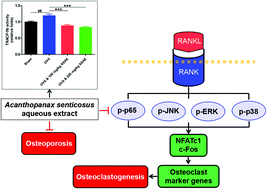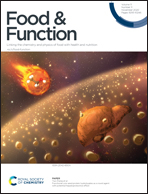Acanthopanax senticosus aqueous extract ameliorates ovariectomy-induced bone loss in middle-aged mice by inhibiting the receptor activator of nuclear factor-κB ligand-induced osteoclastogenesis
Abstract
Acanthopanax senticosus (Ciwujia) has broad-spectrum pharmacological activities, including osteoprotective effects. However, the mechanisms underlying these effects remain unclear. We investigated whether Acanthopanax senticosus aqueous extract (ASAE) ameliorates ovariectomy-induced bone loss in middle-aged mice through inhibition of osteoclastogenesis. In vitro, ASAE significantly suppressed the receptor activator of nuclear factor-κB ligand (RANKL)-stimulated osteoclast differentiation and formation of F-actin rings by downregulating the expression of the nuclear factor of activated T cells, cytoplasmic 1 (NFATc1), c-Fos, and osteoclastogenesis-related marker genes and proteins, including c-Src, tartrate-resistant acid phosphatase (TRAP), cathepsin K, β3-integrin, and matrix metallopeptidase-9 (MMP-9). This was achieved by inhibiting RANK signaling pathways, including p65, c-Jun N-terminal kinase, extracellular signal-regulated kinase, and p38 in osteoclast precursors. In vivo, ASAE markedly ameliorated bone loss in ovariectomized (OVX) middle-aged mice. ASAE significantly inhibited the serum levels of tartrate-resistant acid phosphatase 5b (TRACP-5b) and RANKL, whereas it increased those of osteocalcin, procollagen 1 N-terminal peptide (P1NP), and osteoprotegerin in OVX mice. ASAE significantly inhibited the OVX-induced expression of osteoclast-specific proteins and genes in the femur. In conclusion, ASAE prevents ovariectomy-induced bone loss in middle-aged mice by inhibiting RANKL-induced osteoclastogenesis through suppression of RANK signaling pathways and could be potentially used in mediated treatment of osteoclast-related diseases (e.g., osteoporosis).



 Please wait while we load your content...
Please wait while we load your content...